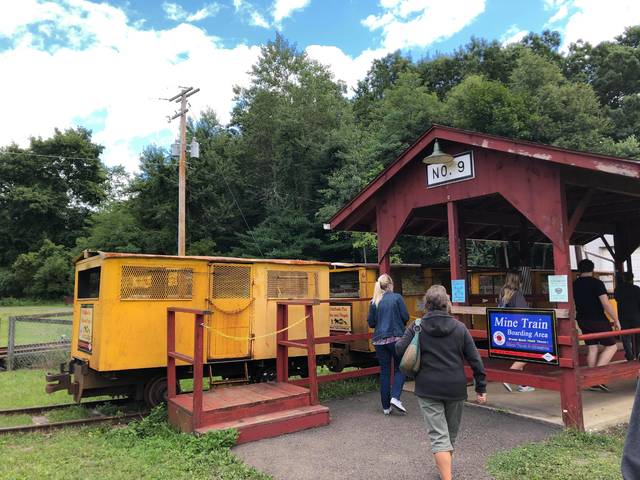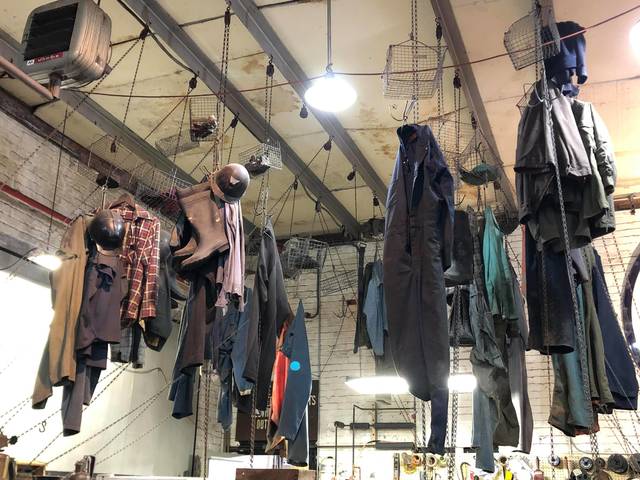
A tour guide sheds some light on the original 900-foot-deep mine shaft at The No. 9 Coal Mine in Lansford. The mine, which closed in 1972, was later reopened as a museum. This weekend the site will offer its annual Civil War encampment and a Sunday picnic with traditional coal region ethnic foods in addition to mine and museum tours.
Roger DuPuis | Times Leader
LANSFORD — Two strains of American history will come together this weekend at an historic industrial site in Carbon County.
The No. 9 Coal Mine and Museum, located at the edge of Lansford Borough in the Panther Creek Valley, will host its annual Labor Day weekend picnic and Civil War encampment — in addition to offering mine tours, as always, and items for sale in the museum gift shop.
That pairing makes sense, since coal fueled Northern industry and the war effort, giving Pennsylvania and the rest of the Union a critical edge in the war between the states.
The coal mine and museum tours and Civil War living history encampment will be held all weekend long, rain or shine.
On Sunday, Sept. 6, there also will be homemade coal region ethnic foods for sale and music from DJ Shawn from 11 a.m. to 4 p.m.
For those who haven’t been, the mine and museum offer an up-close view of what anthracite mining looked and felt like during the industry’s heyday in northeastern Pennsylvania.
Industrial legacy
Opened in 1855, the No. 9 mine was worked until June 1972, making it the longest continuously operated anthracite coal mine in the world, according to the museum’s website. Left abandoned for two decades, the mine was acquired by what is now the Panther Creek Valley Foundation in 1992, and after years of work and restoration opened for public tours in 2002.
Lansford, together with the adjacent borough of Coaldale, in Schuylkill County, and nearby Summit Hill, were essentially “patch towns” that had grown up around the mining industry that dominated the Panther Creek Valley. That industry was for nearly 150 years exclusively controlled by the Lehigh Coal & Navigation Co. (popularly dubbed the Old Company), one of the pioneers of the Industrial Revolution in American — and, which, incidentally, owned 10,000 acres, encompassing the entire Panther Creek Valley.
Drive around Lansford, Coaldale and Summit Hill and traces of the coal industry are everywhere, from the spires of Orthodox churches built to serve immigrant families, to Coaldale Miners Memorial Park on state Route 209, to the lines of coal-filled railroad cars that rumble along the line through the valley, testament to the mining that still takes place in the region, which sits above valuable coal seams.
An educational experience
While No. 9’s working days are long over, it still stands as a monument to the industry, and an educational resource for those curious about what mining was like.
A visit to the site begins in the museum building, a former wash shanty that houses a gift shop in addition to a large hall of artifacts related to the history of No. 9 and the coal region in general, from signs and tools to miners’ clothing and scale models of breaker buildings.
From there it is a short walk out to the railroad boarding shed, where guests must duck their heads as they squeeze into the squat yellow mine cars which screech and sway as they carry visitors on a 1,600-foot train ride into and out of the mine.
Unlike the Lackawanna Coal Mine Tour in Scranton, noted for its steep rail line down into a hillside, the No. 9 mine was driven into the mountain slightly uphill, allowing groundwater to naturally run out without the need of pumps, the museum’s website notes.
Once inside, guides lead visitors on a 600-foot walking tour, which includes stops at the original 900-foot-deep mine shaft, an underground hospital for miners, displays of vintage mining equipment, and, yes, glimpses of actual coal among the rock formations.
Discussion during the tours naturally turns to what life was like for the men, boys and mules that worked in this damp, dark environment, which was in pre-electricity days lit only by spluttering helmet lamps that sometimes blew out — resulting in an utter blackness that is briefly demonstrated by turning out the lights.
Temperatures in the mine remain near 50 degrees year round, which is refreshing while the weather above remains hot, as it is during these late summer days.
For anyone curious about the region’s history — especially anyone whose ancestors worked in the mines — the site offers a rich sensory experience that books and photos simply cannot convey.








